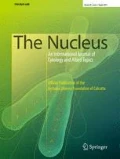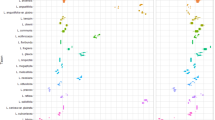Abstract
Spilanthes Jacq. represented by eight species in Kerala state of India is distributed in a wide range of habitats. Many members of the genus are medicinally important. Present study was conducted to find out the chromosome number and ploidy level of existing eight confusing species of Spilanthes collected from different parts of Kerala. The chromosome number varied from 2n = 52 to 2n = 78 with majority of species concentrated in the number 2n = 52, somatic variants were seen in S. ciliata (2n = 78) and S. tetralobata (2n = 65 and 78). This is the first report of chromosome numbers found in three species, S. ghoshinis, S. tetralobata and S. vazhachalensis. The incidence of polyploidy is very much striking in the genus Spilanthes. The members studied showed hexaploid, pentaploid and tetraploid condition, with the basic chromosome number X = 13. Among different species of Spilanthes, S. ghoshinis, S. paniculata and S. uliginosa are tetraploids, S. vazhachalensis is pentaploid, S. calva along with S. radicans are hexaploids. However S. ciliata showed tetraploid and hexaploid plants. S. tetralobata showed tetraploid, pentaploid and hexaploid plants in their natural habitat. The present study confirmed the secondary basic number X = 13 in this genus.

Similar content being viewed by others
References
Barber HN. Hybridisation and the evolution of plants. Taxon. 1970;19:154–9.
Chung KF, Kono Y, Wang C-M, Pen C-I. Bot Stud. 2008;49:73–82.
Jansen RK. Systematics of Spilanthes (Compositae: Heliantheae). Syst Bot. 1981;6:231–57.
Jansen RK. Systematic significance of chromosome numbers in Acmella (Asteraceae). Am J Bot. 1985;72:1835–41.
Jose JC, Mathew PM. Chromosome numbers in the south Indian Heliantheae (Compositae). Compositae Newsl. 1995;27:7–10.
King RM, Robinson H. The genera of the Eupatorieae (Asteraceae): monograph of systematic botany. Mo Bot Gard. 1987;22:1–581.
Mehra PN, Remanandan P. Cytological investigations on Indian Compositae. II. Tribes Asterae, Heliantheae, Helineae and Anthemideae. Caryologia. 1974;27:255–84.
Pushpa K, Laxmi M, Buddha LV. Karyomorphological observations on some taxa of Asteraceae of Nepal. Pleione. 2013;7:219–27.
Rajalakshmi R, Joseph J. Karyomorphometrical analysis of Spilanthes Jacq. (Asteraceae) using image analysis system. Nucleus. 2011;54:159–68.
Reshmi GR, Rajalakshmi R. Spilanthes tetralobata sp. nov. (Asteraceae): a new species from Kerala, India. International. J Adv Res. 2014;2:1092–7.
Sivarajan VV, Philip M. Notes on three new immigrant species of Spilanthes Jacq. (Asteraceae) in India and the identity of the common ‘Tooth- ache plant’. Anc Sci Life. 1983;3:169–73.
Soltis PS, Soltis DE. The role of genetic and genomic attributes in the success of polyploids. Proc Natl Acad Sci. 2000;97:7051–7.
Stebbins GL. Chromosome evolution in higher plants. London: Edward Arnold Ltd; 1971.
Vijayavally B, Mathew PM. Cytotaxonomy of the Liliaceae and allied families. Trivandrum: Continental Publishers; 1990.
Wendel J, Doyle J. Polyploidy and evolution in plants. In: Henry RJ, editor. Plant diversity and evolution: genotypic and phenotypic variation in higher plants. Wallingford: Commonwealth Agricultural Bureaux International; 2005. p. 97–117.
Acknowledgments
The first author thanks Kerala State Council for Science, Technology and Environment (KSCSTE), Government of Kerala, Thiruvananthapuram, India, for its financial support to carry out Ph.D. studies.
Author information
Authors and Affiliations
Corresponding author
Rights and permissions
About this article
Cite this article
Ramachandran, R.G., Rajalakshmi, R. Chromosome number and polyploidy in Spilanthes Jacq. (Asteraceae: Heliantheae). Nucleus 58, 107–109 (2015). https://doi.org/10.1007/s13237-015-0139-y
Received:
Published:
Issue Date:
DOI: https://doi.org/10.1007/s13237-015-0139-y




